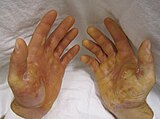

| Epidermolysis bullosa simplex | |
|---|---|
 | |
| Epidermolysis bullosa simplex | |
| Specialty | Medical genetics |
Epidermolysis bullosa simplex (EBS) is a disorder resulting from mutations in the genes encoding keratin 5orkeratin 14.[1]: 598 [2]
Epidermolysis bullosa simplex (EBS) is one of the major forms of epidermolysis bullosa, a group of genetic conditions that cause the skin to be very fragile and to blister easily.[3] Blister formation of EBS occurs at the dermal-epidermal junction.[4]
This section is empty. You can help by adding to it. (October 2023)
|
Epidermolysis bullosa simplex is caused by genetic mutations that prevent the proper formation of protein structures in the skin’s epidermis. This results in skin that blisters easily, from even minor insults. The affected genes, KRT5 and the KRT14, which are responsible for the creation of keratin 5 and keratin 14 proteins respectively, are tied to the four major types of epidermolysis bullosa simplex. However, a small number of epidermolysis bullosa simplex patients do not have mutations in their KRT5 and KRT14 genes. Mutations in the PLEC gene are also being researched, specifically in the gene’s role in the Ogna form of epidermolysis bullosa simplex. The PLEC gene is responsible for the formation of plectin, another skin protein that attaches the epidermis to the skin’s deeper layers.[5]
Epidermolysis bullosa simplex may be divided into multiple types:
| Type | Locus & Gene | OMIM |
|---|---|---|
| Epidermolysis bullosa simplex with migratory circinate erythema | 12q13 (KRT5) | 609352 |
| Epidermolysis bullosa simplex with mottled pigmentation. | 12q13 (KRT5) | 131960 |
| Epidermolysis bullosa simplex, autosomal recessive | 17q12-q21 (KRT14) | 601001 |
| Generalized epidermolysis bullosa simplex | 17q12-q21 (KRT5), 12q13 (KRT14) | 131900 |
| Localized epidermolysis bullosa simplex | 17q12-q21 (KRT5), 17q11-qter, 12q13 (KRT14) | 131800 |
| Epidermolysis bullosa herpetiformis | 17q12-q21 (KRT5), 12q13 (KRT14) | 131760 |
Epidermolysis bullosa simplex with muscular dystrophy
|
8q24 (PLEC1) | 226670 |
| Epidermolysis bullosa simplex with pyloric atresia | 8q24 (PLEC1) | 612138 |
| Epidermolysis bullosa simplex of Ogna | 8q24 (PLEC1) | 131950 |
| Classification |
|
|---|---|
| External resources |
|
Diseases of the skin and appendages by morphology
| |||||||||||||||||||||||||||||||||||
|---|---|---|---|---|---|---|---|---|---|---|---|---|---|---|---|---|---|---|---|---|---|---|---|---|---|---|---|---|---|---|---|---|---|---|---|
| Growths |
| ||||||||||||||||||||||||||||||||||
| Rashes |
| ||||||||||||||||||||||||||||||||||
| Miscellaneous disorders |
| ||||||||||||||||||||||||||||||||||
|
Cytoskeletal defects
| |||||||||||||||
|---|---|---|---|---|---|---|---|---|---|---|---|---|---|---|---|
| Microfilaments |
| ||||||||||||||
| IF |
| ||||||||||||||
| Microtubules |
| ||||||||||||||
| Membrane |
| ||||||||||||||
| Catenin |
| ||||||||||||||
| Other |
| ||||||||||||||
Related topics: Cytoskeletal proteins | |||||||||||||||